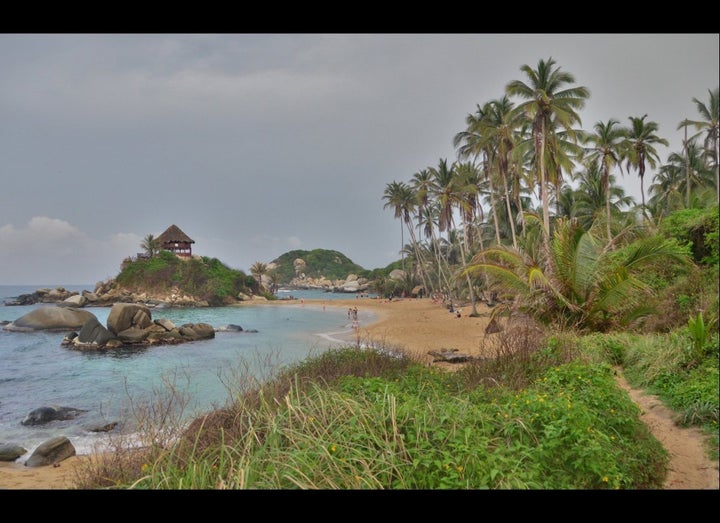
In mid-April, the Summit of the Americas was held in Cartagena, Colombia. Of course, the Summit will be most remembered for the scandal of the U.S. Secret Service who were there to prepare the way for the visit by President Obama, but who were more interested in bedding down prostitutes and then refusing to pay.
However, two important, and equally disturbing, developments also came out of the summit: (1) President Obama announced that the U.S. would be implementing the Free Trade Agreement (FTA) with Colombia this month; and (2) Obama announced that the U.S would be sending U.S. brigade commanders to advise the Colombian military and police in their counter-insurgency campaign. While the former announcement was widely publicized, the latter was not -- this, despite the fact that both policies are closely related.
The FTA is designed to open Colombia up for greater exploitation and penetration by multi-national corporations, particularly by those in the extractive industries such as oil, coal, ethanol (from palm oil), gold and other precious metals. As an excellent report by Peace Brigades International (PBI) explains, in the past 10 years (that is, in the years leading up to final passage of the FTA), 40 percent of all Colombian land has been "awarded or solicited by mining and crude oil companies." PBI further explains:
Of the 114 million hectares of Colombia's extensive and prosperous territory, more than 8.4 million have been licensed for mineral deposit exploration and more than 37 million hectares are licensed for crude oil exploration. Moreover, according to the Ministry of Agriculture and Rural Development more than 5.8 million hectares of land were licensed for mining non-renewable resources in 2010.
As PBI explains, Colombia is indeed a resource-rich country, with a rich supply of gold, emeralds, silver, platinum, nickel and copper; the "largest coal reserves in all of Latin America"; and oil production comparable to that of neighboring Venezuela and surpassing that of Egypt. However, the price for extracting these valuable resources in Colombia is enormous, with millions of Colombians literally paying for this extraction with their lives, lands and homes. Thus, as PBI relates, "80 percent of the human rights abuses in Colombia in the last ten years were committed in mining and energy-producing regions, and 87 percent of Colombia's displaced population originate from these places." Such displacement is unprecedented in the world, with Colombia now possessing the largest internally displaced population on earth at over 5 million (out of a population of around 45 million). In other words, as a direct consequence of the mining efforts taking place in Colombia, over 10 percent of the Colombian population is now internally displaced -- a quite staggering figure.
What's more, such displacement disproportionately falls upon the 102 indigenous groups in Colombia as well the Afro-Colombian population. In an interview I had with Gimena Sánchez of the Washington Office on Latin America (WOLA) for this article, she explained:
Currently, over 30 distinct indigenous groupings are at risk of becoming culturally and physically extinct due to violence, displacement and lack of protection for their collective land rights. Large-scale mining operations that form part of the economic engine promoted by the Santos Administration are projected in many indigenous collective lands and this will worsen the human rights crisis they are facing. A similar situation is happening in Afro-Colombian territories, unfortunately, the legacy of slavery that includes racial discrimination has made the Afrodescendant scenario less visible in Colombia and their cases are not as well-documented as those of the indigenous [...] underlying much of Colombia's more current violent displacement are economic interests. A battle to control Afro-Colombian and indigenous territories is taking place for legal and illegal economic interests. Colombia wishes to secure these areas militarily so that it can implement large-scale development projects that will mostly benefit multinational and Colombian companies. The Colombian government, companies and multi-nationals just see dollar signs when it comes to Afro-Colombian and indigenous collective lands because of the minerals and biodiversity contained in them.
The U.S. is enthusiastically providing the military support to allow the Colombian government to wrench this land away from the indigenous and Afro-Colombian groups through violence. Thus, since 2000, the U.S. has supplied around $8 billion in military aid to Colombia, making Colombia one of the largest recipients of military aid in the world. Now, according to The Wall Street Journal, President Obama is upping the ante, announcing at the Summit of the Americas that the U.S. would be sending "U.S. brigade commanders with hands-on counterinsurgency experience in Afghanistan and Iraq to spend two weeks with Colombian army and police units being deployed in rebel strongholds" to help subdue those areas.
These commanders are in addition to the already 250 U.S. military personnel in Colombia - a figure which, as the Wall Street Journal explains, does not include the CIA and DEA operatives in that country. While the U.S. and Colombia already have "set up about five Joint Task Forces in areas where the FARC" are most active, the goal is to create seven such task forces. Moreover, while The Wall Street Journal claims that the U.S. is merely considering Colombia's request for drones to help in the counter-insurgency efforts, other sources, including The Washington Post (reviewing Wikileaks documents) and the Business Insider, have reported that the U.S. has been supplying Colombia with drones since 2006, though the U.S. continues to take pains to keep this under the radar screen.
And, though the U.S. claims it is helping the Colombian military to subdue areas to fight drugs, it is in fact clear that those areas are to be subdued for exploitation by multinational corporations (mostly from the U.S. and Canada) in the extractive industries. Not surprisingly, then, the U.S. commanders will be operating out of a base in Tibu, Colombia -- home to vast supplies of palm and crude oil. As an added bonus, Tibu is on the Venezuelan border, allowing the U.S. and Colombia to intimidate Venezuela and its president, Hugo Chavez.
The U.S. assistance will include aiding Colombia with "its own version of the U.S. military's Joint Special Operations Command to conduct hunt-and-kill missions," again aimed exclusively at the left-wing FARC rebels and not at the right-wing paramilitary groups which are aligned with the Colombian state and which are responsible for most of the human rights abuses in Colombia. Indeed, as a good analysis by Susana Pimiento and John Lindsay-Poland of the Fellowship of Reconciliation explains:
U.S. participation in such an aggressive military campaign would undercut prospective attempts to negotiate a settlement of the armed conflict, which has increasing support in Colombia. The campaign which apparently does not target successor paramilitary groups, is also likely to benefit those groups which continue to commit human rights abuses, engage in drug trafficking, and operate in more than 400 municipalities in 31 Colombian states, according to a report by the Institute of Development and Peace, INDEPAZ.
Already, the announcement of the imminent implementation of the FTA, in conjunction with the announcement of the U.S.'s heightened military role in Colombia, is emboldening those forces in Colombia (mostly those aligned with the Colombian state) bent on violently repressing those who non-violently engaged in the struggle for peace, land and labor rights. Thus, as Justice for Colombia has reported, on April 26, the Colombian army assassinated a community leader named Duvier Celeita Cifuentes, an organizer with the agricultural union Sintrapaz which is calling for a peaceful settlement to the armed conflict in Colombia. On April 27, a bodyguard to Alfonso Castillo, the President of ANDAS (the National Association of Displaced Persons), was murdered. In addition, Martha Cecilia Guevara, a local organizer of the national peace march held in Bogota (the Patriotic March) disappeared on April 18 just as she was preparing to go to the march. Similarly, on April 18, Herman Henry Dias, a peasant organizer with FENSUAGRO, was killed, presumably by the Colombian military, after he had organized the Putumayo contingent to the Patriotic March.
With the intensification of the U.S. military and economic push in Colombia, we sadly can anticipate more such violence against peaceful actors in Colombia in order to make Colombian land secure for massive appropriation and exploitation. It is such violence and loss of life which is the true cost of U.S. intervention in Colombia. Indeed, the Secret Service scandal has become an apt metaphor for U.S. involvement in Colombia and the rest of Latin America, for the U.S. continues do to all of Latin America what the Secret Service did to those women in Cartagena.
